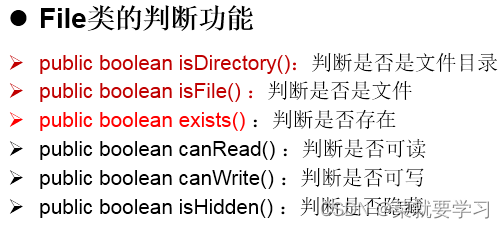目录
2.1 重要流结构(inputstream/outputstream 字节流,reader/writer 字符流)
2.3 FileInputStream / FileOutputStream的使用:
2.4 使用BufferedInputStream和BufferedOutputStream:处理非文本文件
2.5 使用BufferedReader和BufferedWriter:处理文本文件
1. File类
1.1 说明
- File类的一个对象,代表一个文件或一个文件目录(俗称:文件夹)
- File类声明在java.io包下
- File类中涉及到关于文件或文件目录的创建、删除、重命名、修改时间、文件大小等方法,不能读取或写入文件内容(使用IO流实现)
1.2 File的实例化
构造器: File(String filePath)
File(String parentPath,String childPath)
相对路径:相较于某个路径下,指明的路径。
相对路径在IDEA和Eclipse中使用的区别?
IDEA:
如果使用单元测试方法,相对路径基于当前的Module的。
如果使用main()测试,相对路径基于当前Project的。
Eclipse:
单元测试方法还是main(),相对路径都是基于当前Project的。
绝对路径:包含盘符在内的文件或文件目录的路径
路径分隔符
windows和DOS系统默认使用“\”来表示
UNIX和URL使用“/”来表示
1.3 File类的常用方法



2. IO流
2.1 重要流结构(inputstream/outputstream 字节流,reader/writer 字符流)
* 1.操作数据单位:字节流(8bit)、字符流(16bit)
* 2.数据的流向:输入流、输出流
* 3.流的角色:节点流、处理流



* 1. 对于文本文件(.txt,.java,.c,.cpp),使用字符流处理
* 2. 对于非文本文件(.jpg,.mp3,.mp4,.avi,.doc,.ppt,...),使用字节流处理
缓冲流 作用:提高流的读取、写入的速度
原因:内部提供了一个缓冲区。默认情况下是8kb
使用BufferedInputStream和BufferedOutputStream:处理非文本文件
使用BufferedReader和BufferedWriter:处理文本文件
转换流 作用:提供字节流与字符流之间的转换 其属于字符流
InputStreamReader:将一个字节的输入流转换为字符的输入流
解码:字节、字节数组 --->字符数组、字符串
InputStreamReader isr = new InputStreamReader(fis,"UTF-8");//字符集需与文件保持一致
OutputStreamWriter:将一个字符的输出流转换为字节的输出流
编码:字符数组、字符串 ---> 字节、字节数组
OutputStreamWriter osw = new OutputStreamWriter(fos,"UTF-8");
对象流 作用:内存中的对象与二进制流的相互转换
ObjectOutputStream:内存中的对象--->存储中的文件、通过网络传输出去:序列化过程
oos = new ObjectOutputStream(new FileOutputStream("object.dat"));
oos.writeObject(new String("我爱北京天安门"));
oos.flush();//刷新操作
ObjectInputStream:存储中的文件、通过网络接收过来 --->内存中的对象:反序列化过程
ois = new ObjectInputStream(new FileInputStream("object.dat"));
Object obj = ois.readObject();
String str = (String) obj;
2.2 FileReader/FileWriter的使用:
2.2.1 输入过程(读取)
① 创建File类的对象=File类的实例化,指明读取的数据的来源。
File file = new File("hello.txt");
读入的文件一定要存在,否则就会报FileNotFoundException。
② 创建相应的输入流=FileReader流的实例化,将File类的对象作为参数,传入流的构造器中
FileReader fr = new FileReader(file);
③ 具体的读入过程:
1.read():返回读入的一个字符。如果达到文件末尾,返回-1
int data;
while((data = fr.read()) != -1){
System.out.print((char)data);
}
2.创建相应的byte[] 或 char[]。
read(char[] cbuf):返回每次读入cbuf数组中的字符的个数。如果达到文件末尾,返回-1
char[] cbuf = new char[5];
int len;
while((len = fr.read(cbuf)) != -1){
for(int i = 0;i < len;i++){
System.out.print(cbuf[i]);
}
}
④ 关闭流资源
if(fr != null)
fr.close();
异常的处理:为了保证流资源一定可以执行关闭操作。需要使用try-catch-finally处理//ALT+SHIFT+Z
try{ 操作1,2,3
}catch (IOException e) {
e.printStackTrace();
} finally {操作4(注意close()异常,try-catch)}
2.2.2 输出过程
① 创建File类的对象,指明写出的数据的位置。(不要求此文件一定要存在)
File file = new File("hello1.txt");
File对应的硬盘中的文件如果不存在,自动创建此文件。
② 创建相应的输出流,将File类的对象作为参数,传入流的构造器中
FileWriter fw = new FileWriter(file,false);
具体的File对应的硬盘中的文件如果存在:
如果流使用的构造器是:FileWriter(file,false) / FileWriter(file):对原有文件的覆盖
如果流使用的构造器是:FileWriter(file,true):在原有文件基础上追加内容
FileWriter(pathname,append)
③ 写出过程:
write(char[]/byte[] buffer,0,len)
fw.write("I have a dream!\n");
④ 关闭流资源
if(fw != null) fw.close();
说明:程序中出现的异常需要使用try-catch-finally处理。
2.3 FileInputStream / FileOutputStream的使用:
/*
实现对图片的复制操作
*/
@Test
public void testFileInputOutputStream() {
FileInputStream fis = null;
FileOutputStream fos = null;
try {
//1.造文件
File srcFile = new File("爱情与友情.jpg");
File destFile = new File("爱情与友情2.jpg");
//2.造流
fis = new FileInputStream(srcFile);
fos = new FileOutputStream(destFile);
//3.复制的过程
byte[] buffer = new byte[5];
int len;
while((len = fis.read(buffer)) != -1){
fos.write(buffer,0,len);
}
} catch (IOException e) {
e.printStackTrace();
} finally {
if(fos != null){
//4.关闭流
try {
fos.close();
} catch (IOException e) {
e.printStackTrace();
}
}
if(fis != null){
try {
fis.close();
} catch (IOException e) {
e.printStackTrace();
}
}
}
}2.4 使用BufferedInputStream和BufferedOutputStream:处理非文本文件
1.造文件
2.造流——造节点流,造缓冲流
3.复制的细节:读取、写入
byte[] buffer = new byte[1024];
int len;
while((len = bis.read(buffer)) != -1){ //通过缓冲流对象操作
bos.write(buffer,0,len);
}
4.资源关闭 要求:先关闭外层的流(缓冲流),再关闭内层的流(节点流)(随外层自动关闭)
//实现文件复制的方法
public void copyFileWithBuffered(String srcPath,String destPath){
BufferedInputStream bis = null;
BufferedOutputStream bos = null;
try {
//1.造文件
File srcFile = new File(srcPath);
File destFile = new File(destPath);
//2.造流
//2.1 造节点流
FileInputStream fis = new FileInputStream((srcFile));
FileOutputStream fos = new FileOutputStream(destFile);
//2.2 造缓冲流
bis = new BufferedInputStream(fis);
bos = new BufferedOutputStream(fos);
//3.复制的细节:读取、写入
byte[] buffer = new byte[1024];
int len;
while((len = bis.read(buffer)) != -1){
bos.write(buffer,0,len);
}
} catch (IOException e) {
e.printStackTrace();
} finally {
//4.资源关闭
//要求:先关闭外层的流,再关闭内层的流
if(bos != null){
try {
bos.close();
} catch (IOException e) {
e.printStackTrace();
}
}
if(bis != null){
try {
bis.close();
} catch (IOException e) {
e.printStackTrace();
}
}
//说明:关闭外层流的同时,内层流也会自动的进行关闭。关于内层流的关闭,我们可以省略.
// fos.close();
// fis.close();
}
}2.5使用BufferedReader和BufferedWriter:处理文本文件
public void testBufferedReaderBufferedWriter(){
BufferedReader br = null;
BufferedWriter bw = null;
try {
//创建文件和相应的流
br = new BufferedReader(new FileReader(new File("dbcp.txt")));
bw = new BufferedWriter(new FileWriter(new File("dbcp1.txt")));
//读写操作
//方式一:使用char[]数组
// char[] cbuf = new char[1024];
// int len;
// while((len = br.read(cbuf)) != -1){
// bw.write(cbuf,0,len);
// // bw.flush();
// }
//方式二:使用String
String data;
while((data = br.readLine()) != null){
//方法一:
// bw.write(data + "\n");//data中不包含换行符
//方法二:
bw.write(data);//data中不包含换行符
bw.newLine();//提供换行的操作
}
} catch (IOException e) {
e.printStackTrace();
} finally {
//关闭资源
if(bw != null){
try {
bw.close();
} catch (IOException e) {
e.printStackTrace();
}
}
if(br != null){
try {
br.close();
} catch (IOException e) {
e.printStackTrace();
}
}
}
}
3. 随机存取文件流:RandomAccessFile
- RandomAccessFile直接继承于java.lang.Object类,实现了DataInput和DataOutput接口
- RandomAccessFile既可以作为一个输入流,又可以作为一个输出流
raf2 = new RandomAccessFile(new File("爱情与友情1.jpg"),"rw"); - 如果RandomAccessFile作为输出流时,写出到的文件如果不存在,则自动创建。
- 如果写出到的文件存在,则会对原文件内容进行覆盖。(默认情况下,从头覆盖)
- 可以通过相关的操作,实现RandomAccessFile“插入”数据的效果。
* seek(int pos) 将指针调到角标为pos的位置
raf1.write("插入的数据".getBytes());
@Test
public void test1() {
RandomAccessFile raf1 = null;
RandomAccessFile raf2 = null;
try {
//1.
raf1 = new RandomAccessFile(new File("爱情与友情.jpg"),"r");
raf2 = new RandomAccessFile(new File("爱情与友情1.jpg"),"rw");
//2.
byte[] buffer = new byte[1024];
int len;
while((len = raf1.read(buffer)) != -1){
raf2.write(buffer,0,len);
}
} catch (IOException e) {
e.printStackTrace();
} finally {
//3.
if(raf1 != null){
try {
raf1.close();
} catch (IOException e) {
e.printStackTrace();
}
}
if(raf2 != null){
try {
raf2.close();
} catch (IOException e) {
e.printStackTrace();
}
}
}
}
典型代码2:
/*
使用RandomAccessFile实现数据的插入效果
*/
@Test
public void test3() throws IOException {
RandomAccessFile raf1 = new RandomAccessFile("hello.txt","rw");
raf1.seek(3);//将指针调到角标为3的位置
//保存指针3后面的所数据到StringBuilder中
StringBuilder builder = new StringBuilder((int) new File("hello.txt").length());
byte[] buffer = new byte[20];
int len;
while((len = raf1.read(buffer)) != -1){
builder.append(new String(buffer,0,len)) ;
}
//调回指针,写入“xyz”
raf1.seek(3);
raf1.write("xyz".getBytes());
//将StringBuilder中的数据写入到文件中
raf1.write(builder.toString().getBytes());
raf1.close();
//思考:将StringBuilder替换为ByteArrayOutputStream
}






















 980
980











 被折叠的 条评论
为什么被折叠?
被折叠的 条评论
为什么被折叠?








